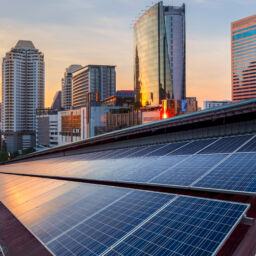On 18 May 2022, the European Commission (EC) published the REPowerEU plan[1] – a package of planned-to-be-adopted proposals aimed at rapidly reducing the EU’s dependence on Russian fossil fuels by, i.a. accelerating the energy transition and facilitating investment in renewable energy sources (RES).
The actions proposed under REPowerEU are divided into the following areas:
- save energy;
- diversify supplies;
- quickly substitute fossil fuels by accelerating Europe’s clean energy transition;
- smartly combine investments and reforms (including speeding up the permitting of RES projects).
Selected aspects of the REPowerEU plan are explained below, with particular focus on the development of renewable energy.
I. SAVE ENERGY[2]
The EC considers it necessary to reduce energy consumption in Europe which should also result in lower energy prices. Energy savings are to be achieved, i.a. through investments in RES, increasing energy efficiency, and changing the behaviour of energy consumers. Moreover, the EC proposed the application of a reduced VAT rate to highly efficient heating systems and building insulation, and came forward with a legislative initiative[3] that, i.a. raises the EU target of increasing energy efficiency by 13% by 2030 compared to 2020 (currently it is 9%).[4]
II. DIVERSIFY SUPPLIES
The EU Energy Platform for the voluntary common purchase of gas, LNG, and hydrogen, established under a European Council mandate, is to be the main tool to achieve this target.[5] In scope of the REPowerEU plan, it will primarily be used for common purchases of gas, implemented by way of identifying existing and expiring long-term contracts, and conclusion of new multilateral agreements. The negotiation and conclusion of gas supply contracts on behalf of the participating countries[6] will be carried out through a general voluntary common purchasing mechanism or regional task forces created for this purpose (the first of which was established on 5 May this year in Bulgaria). Other actions planned include introducing a mechanism and IT tools to facilitate the booking of infrastructure capacity for gas import, transmission, and storage.
III. REPLACING FOSSIL FUELS WITH RENEWABLE ENERGY SOURCES
Within the third and most comprehensive part of the REPowerEU plan, the following priorities are distinguished, i.a:
- developing renewable energy,
- accelerating the use of hydrogen,
- increasing the production and use of biomethane,
- reducing the use of fossil fuels in industrial and transport sectors from which emissions are difficult to reduce, and
- accelerating the permitting of and innovation in the renewable energy sector (explained further in section IV below).
The following actions and targets are included, among else, in the EC’s plan:
- raising the existing target for the share of RES in gross final energy consumption from 32% in 2030[7] to 45%;
- installing more than 320 GW of new solar photovoltaic (PV) plants by 2025 and 600 GW by 2030;
- doubling the rate of deploying individual heat pumps (to 10 million units over the next 5 years);
- producing 10 million tons of renewable hydrogen by 2030 and importing the same amount;
- publishing, for public consultation, two Delegated Acts on the definition and production of renewable hydrogen;
- increasing sustainable biomethane production to 35 billion m3 by 2030 and providing incentives for upgrading biogas into biomethane, and;
- the increased electrification of industry.
IV. COMMISSION RECOMMENDATION ON SPEEDING UP PERMIT-GRANTING PROCEDURES FOR RENEWABLE ENERGY PROJECTS
The REPowerEU plan frequently highlights the need to accelerate the development of renewable energy in the EU. The Commission has paid attention to the administrative procedural barriers that are stopping this development. Therefore, at the same time as announcing the plan, the EC issued a recommendation on speeding up permit-granting procedures for renewable energy projects and facilitating power purchase agreements.[8]
The key proposals contained in the EC Recommendation are:
- applying the most favourable administrative procedures available for the planning, building, and operating RES plants and connecting them to the grid;
- qualifying RES (and energy storage) investments as being in the overriding public interest and in the interest of public safety;
- establishing as short as possible administrative deadlines to build and operate RES plants;
- establishing time frames to prevent the excessive lengths of legal proceedings;
- unifying administrative procedures requiring the submission of several applications (“single window” / “one-stop shop” and other methods of integrating different procedures) and allowing the submission of several applications simultaneously instead of sequentially;
- introducing fully digital permit-granting procedures and e-communication;
- identifying suitable land and sea areas for the priority deployment of RES projects (excluding environmentally valuable areas) and limiting “exclusion zones” for RES projects to the necessary minimum (e.g. through the criteria of distance of RES plants from housing);
- streamlining environmental impact assessment (EIA) requirements;
- implementing long-term grid planning and investment in these grids, consistent with the planned increase in renewable energy production capacity;
- establishing a simplified procedure to repower existing power plants (including EIA) and adopting a simple-notification procedure for grid connection in cases where no significant environmental or social impact is expected;
- applying a transparent and digital procedure for grid connection, providing information on grid capacities, and optimising the use of grid capacity by allowing its use by power plants combining multiple complementary technologies, and
- removing any administrative or market barriers to corporate purchase agreements of renewable energy, and implementing support schemes for such agreements.
Every 2 years, Member States should communicate detailed information to the EC on the state of implementing the Recommendation. Based on a review of that information, the EC may take further action in the future, in particular, legislative initiatives.
V. FINANCING
Implementing the REPowerEU plan requires an additional investment of €210 billion by 2027 (over and above the resources needed to meet the objectives of the “Fit for 55” package). The planned actions will be financed by: the European Regional Development Fund, the European Social Fund Plus, the Cohesion Fund, the Just Transition Fund,[9] the Common Agricultural Policy,[10] ETS funds, Recovery and Resilience Plans (RRPs);[11] also supported by the Connecting Europe Facility Energy (CEF),[12] and the InvestEU Programme.[13]
The EC proposes to direct substantial resources to the accelerated implementation of Projects of Common Interest (PCI)[14] in energy interconnection and infrastructure, and to expand the RRPs with chapters containing new actions to meet the REPowerEU targets to diversify energy supply and reduce fossil fuels dependence.
Investments implementing the targets of the REPowerEU plan will be able to receive state aid. It is planned to adjust state aid guidelines and include some of them in block exemptions, i.e. an exemption from the obligation to notify the EC.
[1] Communication from the Commission to the European Parliament, the European Council, the Council, the European Economic and Social Committee, and the Committee of the Regions, the REPowerEU Plan of 18 May 2022 (COM(2022) 230 final).
[2] More in the Communication from the Commission to the European Parliament, the Council, the European Economic and Social Committee, and the Committee of the Regions, EU ‘Save Energy’ of 18 May 2022 (COM(2022) 240 final).
[3] Proposal for a Directive of the European Parliament and of the Council amending Directive (EU) 2018/2001 on the promotion of the use of energy from renewable sources, Directive 2010/31/EU on the energy performance of buildings, and Directive 2012/27/EU on energy efficiency (COM/2022/222 final).
[4] Amendment of Art. 3 Section 5 of the Directive 2012/27/EU of the European Parliament and the Council of 25 October 2012 on energy efficiency, amending Directives 2009/125/EC and 2010/30/EU and repealing Directives 2004/8/EC and 2006/32/EC (European Journal of Law of 2012 No. 315 with amendments).
[5] Section 17 (b) of the Conclusions of the European Council meeting on 24-25 March 2022 (EUCO 1/22) https://data.consilium.europa.eu/doc/document/ST-1-2022-INIT/en/pdf issued in connection with Section 16-18 of the Versailles Declaration from the informal meeting of the Heads of State or Government on 10-11 March 2022, https://www.consilium.europa.eu/media/54773/20220311-versailles-declaration-en.pdf
[6] Besides EU Member States, these may include, in particular, the countries of the Energy Community – the Western Balkan countries, Georgia, Moldova and Ukraine.
[7] Art. 3 Section 1 of Directive (EU) 2018/2001 of the European Parliament and of the Council of 11 December 2018 on the promotion of the use of energy from renewable sources (European Journal of Law of 2018 No. 328 with amendments).
[8] Commission Recommendation (EU) 2022/822 of 18 May 2022 on speeding up permit-granting procedures for renewable energy projects and facilitating Power Purchase Agreements (C(2022) 3219 final).
[9] Regulation (EU) 2021/1060 of the European Parliament and of the Council of 24 June 2021 laying down common provisions on the European Regional Development Fund, the European Social Fund Plus, the Cohesion Fund, the Just Transition Fund, and the European Maritime, Fisheries and Aquaculture Fund and financial rules for those and for the Asylum, Migration and Integration Fund, the Internal Security Fund and the Instrument for Financial Support for Border Management and Visa Policy (Official Journal of Law of 2021 No. 231 with amendments).
[10] Regulation (EU) 2021/2115 of the European Parliament and of the Council of 2 December 2021 establishing rules on support for strategic plans to be drawn up by Member States under the common agricultural policy (CAP Strategic Plans) and financed by the European Agricultural Guarantee Fund (EAGF) and by the European Agricultural Fund for Rural Development (EAFRD) and repealing Regulations (EU) No 1305/2013 and (EU) No 1307/2013 (Official Journal od law of 2021 No. 435 with amendments).
[11] To direct ETS funds to REPowerEU investments and to revise the RRP, it is planned to amend Regulation (EU) 2021/241 of the European Parliament and of the Council of 12 February 2021 establishing the Recovery and Resilience Facility (Official Journal of Law of 2021 No. 57 with amendments).
[12] Acting based on Regulation (EU) 2021/1153 of the European Parliament and of the Council of 7 July 2021 establishing the Connecting Europe Facility and repealing Regulations (EU) No 1316/2013 and (EU) No 283/2014 (Official Journal of Law of 2021 No. 249).
[13] Acting based on Regulation (EU) 2021/523 of the European Parliament and of the Council of 24 March 2021 establishing the InvestEU Programme and amending Regulation (EU) 2015/1017 (Official Journal of Law of 2021 No. 107).
[14] The term introduced by Regulation (EU) No 347/2013 of the European Parliament and of the Council of 17 April 2013 on guidelines for trans-European energy infrastructure and repealing Decision No 1364/2006/EC and amending Regulations (EC) No 713/2009, (EC) No 714/2009, and (EC) No 715/2009 (Official Journal of Law No. 115 with amendments).









